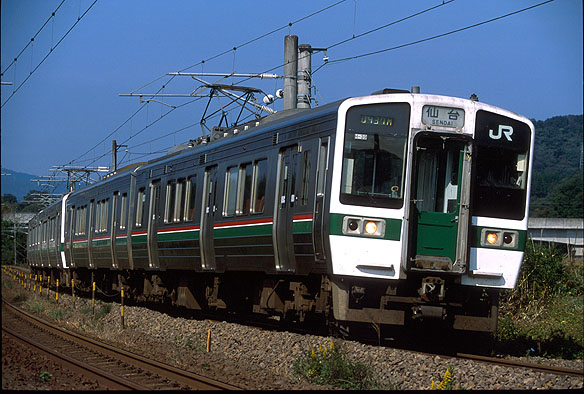Background and overview
Besides 417 series suburban dual voltage AC/DC electric multiple unit (EMU), 715 series suburban AC EMU converted form 583 series EMU, 451, 453, and 455 series express dual voltage AC/DC multiple unit (EMU) were used on the commuter and regional services in Sendai area. However, 451, 453, and 455 series caused delays occur while peak hours frequently because of the vestibuled body having 2 sliding doors at both ends. They were also superannuated. Thus, JR East developed 719 series suburban AC EMU trains to replace them in 1989. 3 two-car sets consisting of a powered end vehicle and a trailer end vehicle were delivered to Sendai depot in December 1989.
Car body
They have 2950mm wide body, incorporating light weight stainless construction.
Bodies are unpainted and have a red and green waistline band running the
length of each car below the windows. Cab ends are covered with a Fiber
Reinforced Plastics (FRP) panel having a gangway painted in green at the
centre. Electrolytic colouring aluminum black plates are fitted above and
below windscreens. Left windshield panel is expanded below to have a commanding
view of the tracks ahead. A destination roll sign is fitted above the gangway
door. They are equipped with 3 stepped double-leaf automatic sliding doors
on each side of the vehicles and pairs of drop windows. Door operating
equipments, TK111, are fitted above the door header of the sliding doors
which can be operated manually by pushing the buttons fitted beside the
door. A drop window and two fixed windows on each side of a drop fixed
window are fitted between the doors. An air conditioner, AU710A rated at
38,000kcal/h, is fitted on the centre of their roof. Forced draft ventilators
are fitted on both side of the air conditioner. Class kumoha719 vehicles
have a low roof section where the current collector is fitted to reduce
upper structure clearance for current pickup, since a tunnel section of
the Senzan line is low. The LED destination indicators are fitted on the
body side. End cars are equipped with the automatic jumper coupler to ease
rush-up operations.
Bogies
The 719 series are equipped with DT32 bogies on the powered vehicles and TR69 bogies on the trailer transplanted from scrapped 485 series EMU, featuring airbags for the secondary suspension, pedestal type journal supporting system, the anti-rolling stabilizer of the torsion bar, and large diameter centre pivot. These bogies were transplanted from disused vehicles. Parallel cardan drive with hollow shaft is applied for power transmission device. The gear ratio is 6.07 to operate at the steep gradient of railways and get the maximum service speed at 110km/h. Their bogies apply the single tread brake device for motored bogies and the disk brake device for trailer bogies.
Traction unit and ancillary equipments
Four powerful shunt-wound brushed DC traction motors, MT61, with a power output of 130kW and featuring high terminal voltage at 400V, are controlled by the traction control system, CS55A, featuring thyristor phase control and holding brake. They feature field added excitation control to expand the field weakening ratio to 33%. Although second wiring coil of the traction transformer, TM22, applied for 713 series are split into 4 sections, that of TM22A or TM22B applied for 719 series are split into 2 sections for light weight. TM22B employs new fire-resistant fluid for insulation. The traction rectifier, RS52, consists of a pair of the thyristor full bridges and a thyristor/diode hybrid bridge. The thyristor full bridges convert alternating current to direct current while power running and change direct current to alternating current as the external excited inverter while regenerating to control armature current. Thyristor/diode hybrid bridge powered by the current of fourth wiring of the traction transformer controls the field weaking ratio. The minimum field weaking ratio is 30% to realize regenerative brake at high-speed range. Class kumoha719 vehicles are equipped with a motor-driven reciprocating air compressor, MH1103-C1000D, under their floor and a diamond-shaped current pickup, PS16H, transplanted from scrapped vehicles on the roof. They feature the electric commanding brake with regenerative brake and holding brake.
Accommodation
They have a transverse bucket seating bay with 1490mm seating pitch at
the centre, two transverse bucket seatings with 845mm seating pitch outer
side of a centre bay, and two longitudinal bench seatings outer side of
the transverse seating. An AC duct is installed above the ceiling and slit-shaped
AC vents are featured in order to improve interior design. Trailer end
vehicles, class Kuha718, are equipped with a Japanese style toilet.
Additional delivery
6 additional two-car sets were delivered over the period from January 1990 until February. In addition, 10 more two-car sets were delivered over the period from March 1990 until May 12 from July 1990 until August, and finally 11 from July 1991 until August.
Operations
They were used on Tohoku line between Kuroiso and Hiraizumi, Senzan line, Banestu west line between Koriyama and Kitakata, and Johban line between Namie and Iwanuma. However, E721-1000 series began to displace 719 series in 2016 and finally 719 series were withdrawn completely in March 2020. |
|

